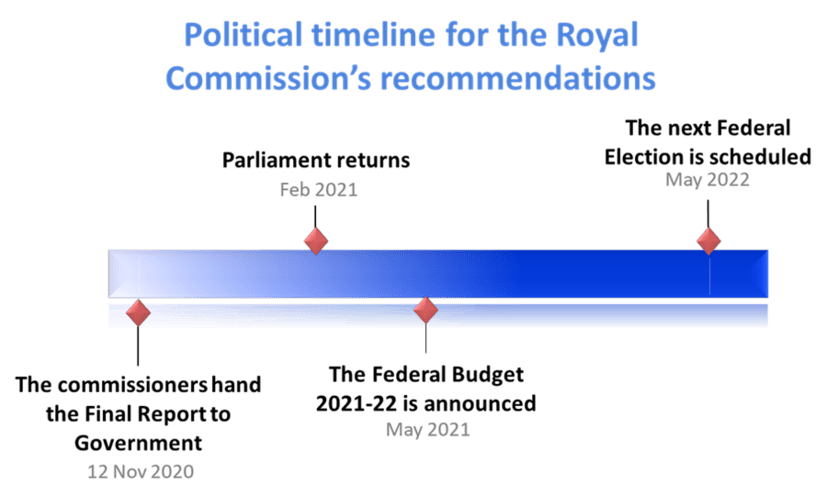The timeline for the implementation of the recommendations from the Royal Commission’s Final Report could stretch into 2022 based on the current political timeframes and previous Royal Commissions.
Following Wednesday’s commitment from Labor leader Anthony Albanese to support the recommendations sight unseen (and not having a chance at gaining office until May 2022), we pulled together a timeline with the key political dates for the Final Report (pictured below):

As you can see, there is still a way to go before the Royal Commission’s promised “comprehensive reform and major transformation of the aged care system” sees the light of day.
Following the Final Report’s release, there are only eight parliamentary sitting days until the end of the year – a tight deadline in which to secure the required commitment from both Parties for the implementation of the recommendations.
Parliament will then not return until early February 2021 when it is more likely there will be announcements.
The Budget – where it would be expected some of the money for the recommendations will be found – is not due until 12 May 2021 – six months after the Final Report’s release.
The pre-election campaign – where both parties would also typically pledge some funding for aged care – won’t kick off until 2022 – almost two years away.
Other Royal Commissions also suggest a ‘slow but steady’ approach by the Government.
The Child Sex Abuse Royal Commission handed in its Final Report on 15 December 2017, but it wasn’t until July 2018 that the National Redress Scheme was set up and only in October 2018 that Prime Minister Scott Morrison delivered the National Apology.
The Banking Royal Commission was released on 4 February 2019 after being passed onto the Government on 1 February, but again the roadmap for the implementation of its 76 recommendations wasn’t released until August 2019 – and none of them took money out of the Government purse unlike aged care.
What are the expectations of the sector?
LASA CEO Sean Rooney (pictured left inset) tells us they hope the Government makes commitments to the Royal Commission recommendations immediately after its November delivery.
“However, we expect major changes will be recommended and acknowledge that tangible responses may take a year or more to be implemented,” he said.
Sean says therefore it is critical for the Government to implement additional funding and reform ahead of the Final Report – including more home care packages and an interim $1.3 billion boost over the next 18 months.
“The sector is dedicated to delivering quality care, providing skilled staff and complying with and exceeding the new Aged Care Standards, but the risk of missed care and service closures is rising with more than 50 per cent of residential care providers operating at a loss.”
LASA also wants a ‘transition’ plan for the sector.
“This plan needs to provide a detailed, sequenced reform plan, that articulates roles, responsibilities and timeframes for implementation of the Royal Commission’s recommended reforms. LASA proposes that the delivery of the transition plan have an independent, governance mechanism in place to hold all players to account in delivering the reform agenda. Similarly, the plan also needs to have clear outcomes and performance metrics, so we track the impact of the reforms as well.”
The Royal Commission has also identified this need to review the reforms as they are rolled out to ensure accountability.
But with the earliest announcements from the Government expected to be November at best – and 2021 at worst – you must ask the question: how many operators will fail in the next 12 months?
StewartBrown Senior Partner Grant Corderoy (pictured right inset) says while they can’t predict numbers, their figures show 57% of operators will be running at a loss by the end of the financial year for 2020.
Of that cohort, 77% of regional, rural and remote facilities will be operating at a loss.
Grant points out that this does not mean those providers will fail.
However, he says while larger operators will be under strain, those most at risk will be the smaller and community-run providers that will be under extreme financial pressure.
LASA’s assessment is similar. Sean says their analysis of Department of Health data for 2018-19 showed 197 homes – caring for around 50,000 residents – were experiencing financial distress.
“We know the funding situation has not improved, with an independent report showing more than 50 per cent of residential care services operated at a loss in the first quarter of this financial year,” he adds.
He says their concern is that without urgent financial support, the risks of missed care and service closures will continue to increase.
“Currently, we know of some homes under severe financial distress and are on the verge of selling assets to survive. They will do everything they can to continue quality care for their residents, but time is running out.”
Testing times ahead.










